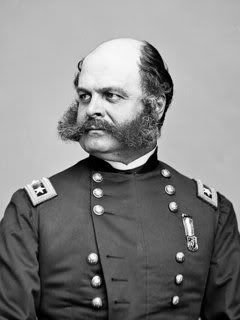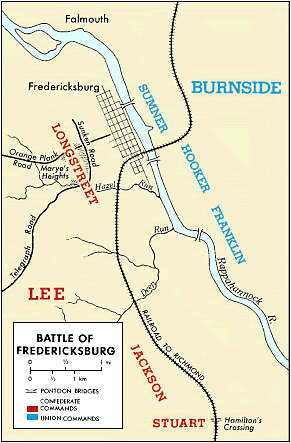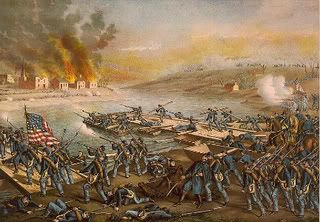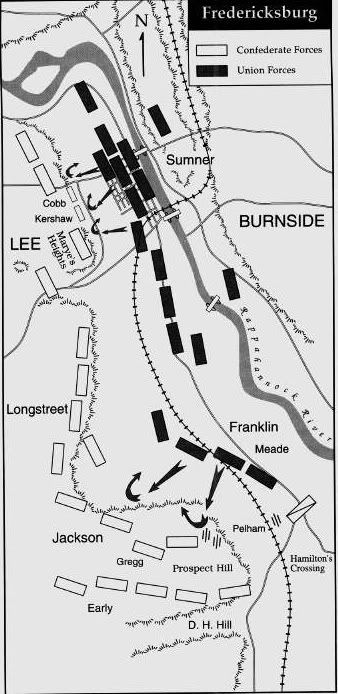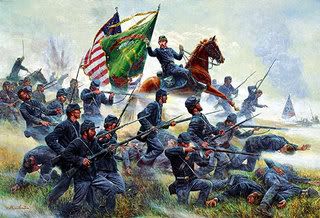 For far too long, capturing Kilinochchi has been a primary goal of the military. Instead, the LTTE's armies, wherever they are at a disadvantage, should themselves be objectives of the Army. (Click to Enlarge)
For far too long, capturing Kilinochchi has been a primary goal of the military. Instead, the LTTE's armies, wherever they are at a disadvantage, should themselves be objectives of the Army. (Click to Enlarge)
For one, many military leaders seem to have a damaging mindset regarding Elephant Pass and Kilinochchi. This mindset has resulted the repeated assaults on the Jaffna Front, each failing just like the one before it. Just as McClellan, Burnside, and a slew of other generals who have not yet been mentioned here led their armies to ruin because of their "On to Richmond!" mentality, Sri Lankan generals seem to have crippled their strategies because of a desire to march on Kilinochchi and recapture Elephant Pass, a symbol of the military's strength up until its capture. These positions should be secondary objectives after a much more important target: the LTTE Army. They should remember that the Confederacy didn't fall because Richmond was taken. Richmond was one of the last cities in The South to fall and had Richmond fallen in 1862, the war would have certainly continued. What finally defeated the Confederacy was a fundamental shift in strategy. The goal to capture Richmond was replaced with an effort to seek out and engage the Confederate Army. When the LTTE’s military has been neutralized, Kilinochchi will take care of itself.
Let the Tigers hold Elephant Pass, and all the rest of the territory between that base and the current trench line. In fact, the longer they hold that position, the longer those soldiers, weapons, and supplies will be denied to the rest of the LTTE. If they remain immobilized because they fear a breakout from Jaffna, they are as good as dead to the soldiers in the South, no even better than dead, since they will continue to consume limited supplies while defending against an attack that should only come if they leave.
 The soldiers on the Jaffna Front are closer to Kilinochchi than any other body of troops, but the heavy rebel defenses makes offensive operations here unwise.
The soldiers on the Jaffna Front are closer to Kilinochchi than any other body of troops, but the heavy rebel defenses makes offensive operations here unwise.
It should be fairly obvious that Jaffna is not a preferable route into the Wanni. Its only advantage is its close proximity to the LTTE's capital. This is far outweighed by the defensive strength of the Jaffna Front. The LTTE has thousands of soldiers there, supported by a large number of mines, mortars, artillery and multiple layers of prepared defenses, even tank immobilizing trenches, concentrated in a tiny area. They have had years to find the exact ranges of any position within range of their guns, allowing them to be able to quickly fire, with nearly instant accuracy.
There is more LTTE firepower concentrated in this small area than on anywhere else on the island, and they get priority on supplies. On the Southern Fronts, while there are more soldiers, mines, and artillery, it is spread along hundreds of miles of front, and is much thinner than in the North. In Mannar, constant minor shifts in the lines have resulted in inferior defensive structures and a more porous border. Regular skirmishing has also caused many fortifications to be lost, resulting in a lack of proper cover and worse living conditions for the LTTE troops. No course of approach will be easy, but compared to the Jaffna Front, it should be clear that the South is the LTTE's soft underbelly.
Given this change in objectives, and a clear understanding that the Wanni should be taken from South to North, the strategic reforms required for victory will have been established. What will remain is the tactical issue of how the advance should be handled. A fear of heavy short-term casualties has resulted in semi-daily minor skirmishing along the Southern Fronts that has gone on since the capture of the Eastern Territories. Winning wars requires decisive action on the part of the aggressor. Since the fall of the East, the military blunders of this war have been made almost exclusively by the Sri Lankan Army, both in its unwillingness to press advantages in the South, and the multiple, inexplicable suicidal assaults on the LTTE’s defenses on the Jaffna Front.
General Ulysses Grant was the Federal commander who ultimately defeated the Confederacy. Accepting some of the heaviest fighting of the war, he used his superior numbers and firepower to its full potential and ended the war. Despite being labeled as a butcher at the time, he ended the war by his actions, while the generals who came before him had lost more men and had nothing to show for it.
If the SLA really wants to end this war, they must utilize those factors that make them superior to the LTTE. Their superior numbers allows the SLA to be many places at once, in force. Instead of limiting the army to small skirmishes that gives the LTTE as close to even odds as they'll ever get, Sri Lankan forces should make large scale assaults, accepting the fact that casualties will be higher up front, but also knowing that fewer will die in the long run, as has been discussed in previous articles. Thousands of soldiers should be committed to offensives to break through LTTE lines in the South and force them to fight without prepared defenses further into the Wanni. There should be multiple efforts, carried out along different points along the Southern Fronts, at the same time to prevent the LTTE from shifting troops or weapons from one front to another.
The Air Force should also play a major role, but only after they too have undergone a major change in their mission. The Air Force has been squandered by Sri Lanka and has been a bittersweet break for the LTTE. The Air Force should end their hunt for the Air Tiger squadron and abort their bombing of the LTTE airstrip. The rebel planes have no real strategic military value and the war would be better served by SLAF air strikes on enemy FDLs. The massive air defense system that has been developed should also be dismantled. Their resources and personnel are needed elsewhere and even if they are successful and destroy the rebel planes, they will have had as little impact on the outcome of the war as the toy planes they eliminated.
Decapitation strikes such as the assassination of Thamilchelvan are worthwhile and important services that the SLAF provides, unlike the pointless hunt for the TAF. However, even this valuable job should be secondary to the support of the Army in its campaign to eradicate the LTTE's armies.
The Air Force should also scale back their role as assassins of LTTE political figures. Let the rebel leaders have a couple days off and spend those limited sorties a week on air strikes against fixed LTTE positions along lines of advance. The successful surgical strikes made by the Air Force are what make the current role of the SLAF bitter for the LTTE, but this should still be modified to fit the new objectives of the military as a whole. Transferring the Air Force’s focus to the LTTE Army instead of their political leadership is another aspect of correcting the military’s primary objectives. This does not mean that political targets should no longer be threatened by any air strike, only that they should not take priority except under exceptional circumstances.
The soldiers who charge the LTTE positions on the Jaffna Front are some of the bravest in this war and it is shameful that they have been repeatedly ordered to mount hopeless assaults on impervious enemy fortifications. The massive casualties that have resulted from these many charges should not have occurred, just as the Federals at Fredericksburg should not have been lead to slaughter by the incompetent General Burnside. So too should these brave soldiers not be slowly picked off in years of skirmishing for minimal gain. The McClellan style conservative strategy has likewise caused many needless deaths and threatens the likelihood of victory. Decisive leadership and an intelligent, aggressive, and well-prioritized strategy offers the promise of total victory, and fewer overall casualties. The Sri Lankan leadership should keep this simple wisdom of General Grant in mind when deciding how to conduct the war:
"The art of war is simple enough. Find out where your enemy is. Get at him as soon as you can. Strike him as hard as you can, and keep moving on."


